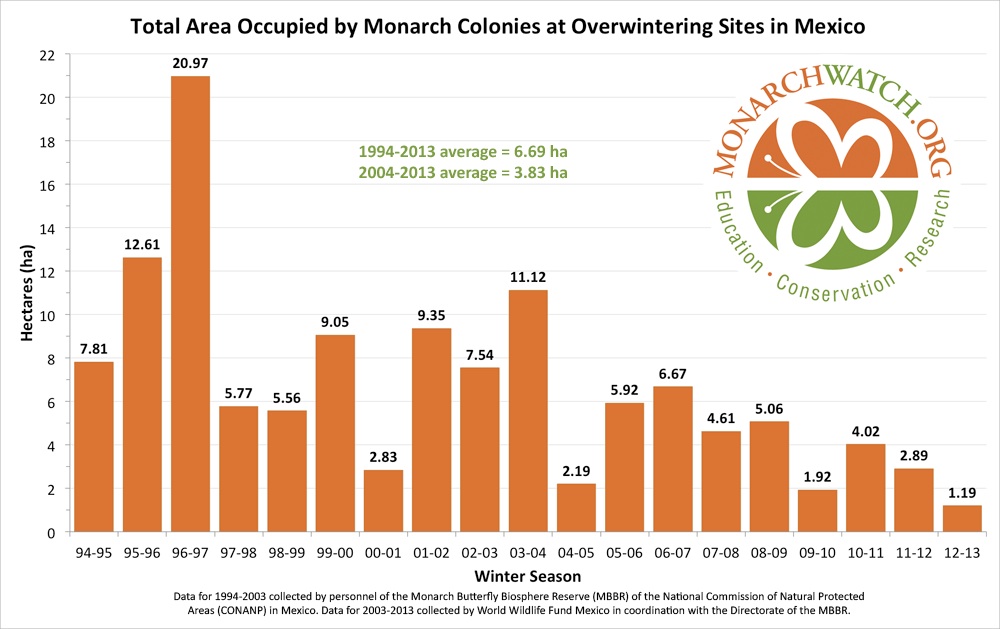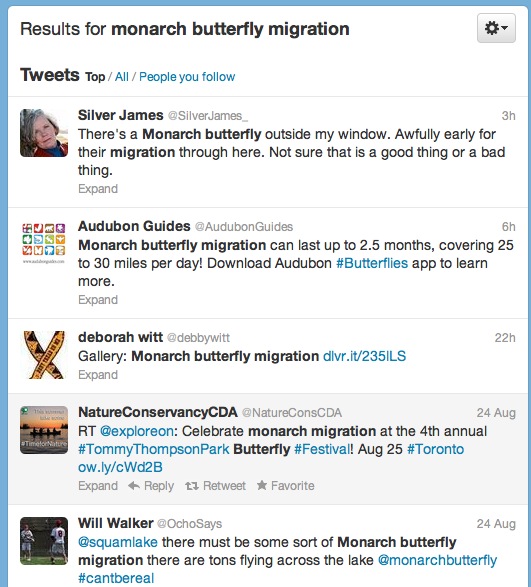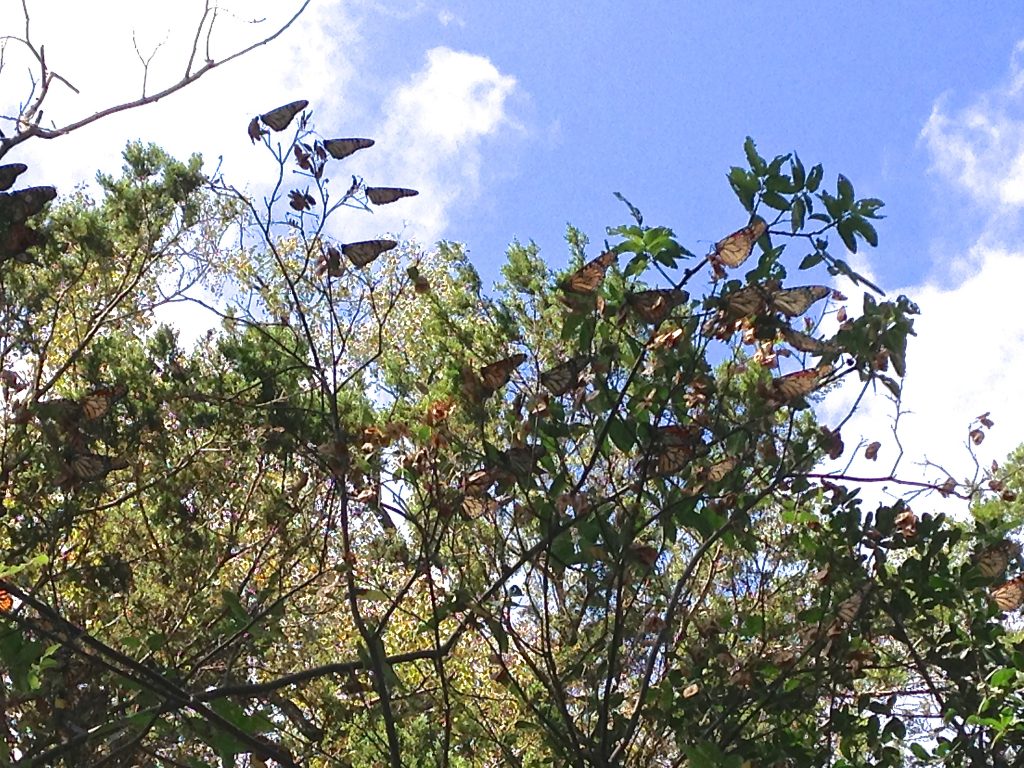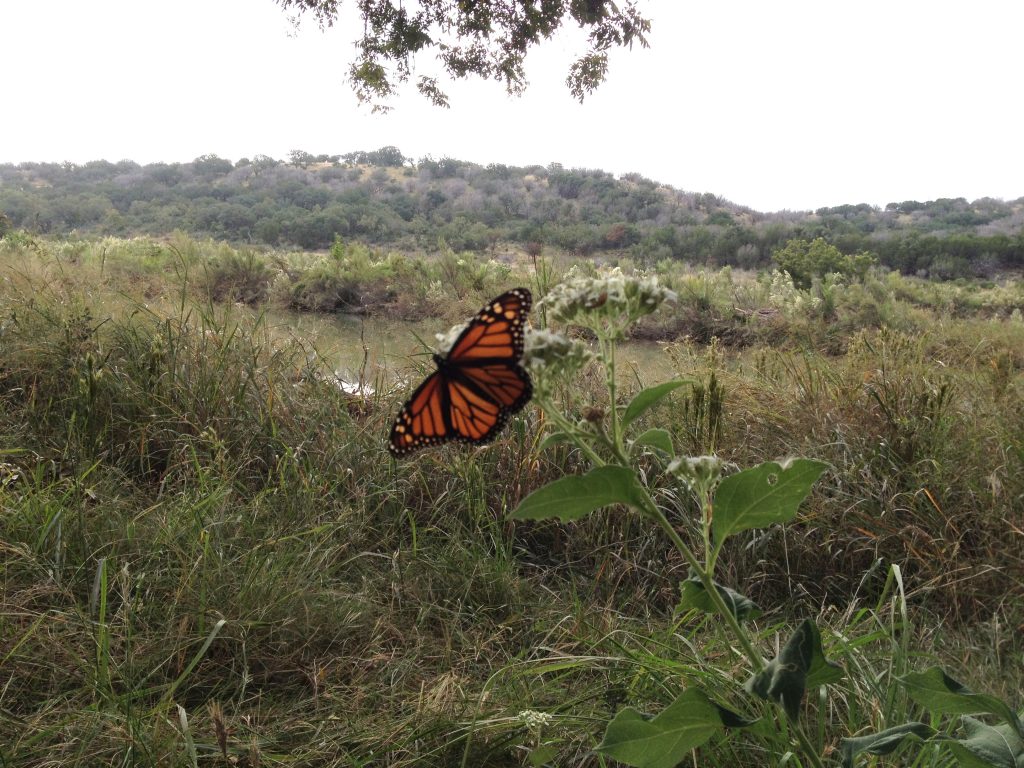The end-of-the-year provokes a look back to assess progress–if any–on the pollinator front. 2014 held a mixed bag of good and bad news with occasional surprising twists.
We started out thinking 2014 might be the worst year in history for Monarchs given that the 2013 migration ranked lowest in population numbers ever. Remember the headlines? “90% drop in Monarch butterflies,” read Newsweek, the Washington Post, the New York Times and other media outlets. But the season surprised us.

Increased, well-timed rains helped pollinators and other wildlife and assuaged–for now–some drought fears, but we’re not able to be complacent. This photo, of the Llano River, was taken in late April. Photo by Monika Maeckle
A reprieve from the drought, well-timed rains in the Midwestern breeding grounds and milder temps in Texas made for a late summer surge, and an exceptional year for Monarch. We look forward to hearing the numbers observed in Michoacán this winter. While this temporary boost won’t fix the longterm, persistent declines caused by pesticide use, genetically modified crops, climate change and general habitat loss, it’s a welcome, unexpected turn.
On the PR front, 2014 couldn’t have been much better in terms of raised awareness. Pollinator peril has gone mainstream.
The First Lady of the United States planted the first pollinator garden at the Whitehouse. The presidents of Mexico, the U.S. and Canada agreed to work together to restore Monarch and other pollinator habitat, and some of the top scientists and pollinator advocacy organizations in the country submitted the Monarch butterfly for consideration as “threatened” under the Endangered Species Act.
Simultaneously, professional butterfly breeders gathered to create programs to systematically combat OE, the Monarch-centric spore driven disease that attacks Monarchs and other milkweed feeders. And a lively debate continues about the appropriateness of planting Tropical milkweed, Asclepias curassavica, the only Monarch host plant commercially available.
Again, while the facts still spell general decline and danger for pollinators, the awareness of the problem has been elevated like never before. That’s all good.
Below are some of the Texas Butterfly Ranch’s top posts written in 2014 that should give you a good perspective on the year.

The decline of the Monarch butterfly population. In the 90s, their roosting grounds averaged 22 acres. Graphic via Monarch Watch
Wake-up Call: Monarch Butterfly Numbers Plummet
In February we wrote the dreary news that for the 2013 season, the entire migrating Monarch butterfly population occupied only .67 hectares. That’s 1.65 acres, 72,000 square feet–or about 35 million butterflies, down from highs of 450 million in years’ past. Think about it: the entire population of migratory Monarch butterflies could easily fit into the average Walmart store, with 30,000 square feet to spare.
First Lady Michelle Obama Gets Milkweed, Plants Pollinator Garden
On April 2,1600 Pennsylvania Avenue added Swamp milkweed, Asclepias incarnata and Butterfly weed, Asclepias tuberosa to its 1500-square-foot vegetable garden. The milkweed species will serve as Monarch host plant as well as a favored nectar source to bees and other butterfly species. The milkweeds also marked the first time in history that a pollinator garden had been planted at the White House.

First Lady Michelle Obama busy at the White House Kitchen Garden where she recently added pollinator plants, including two species of milkweed. Photo via Obama Foodorama3.
Monarch Butterflies Headed our Way in Promising Rebound Season
This year’s migration seemed to start early and end late, with the Monarchs taking their time and reproducing profusely along the way with optimal conditions in their favor. Here in Texas, our season was 7 – 10 later than usual for peak migration.
How to Track the Monarch Butterfly Migration from your Desk
Not everyone can access the Great Outdoors on Demand, especially during butterfly season. This post details how you can track the migraiton from your desk using crowdsourced social media tools and apps like Twitter, Facebook, Journey North and Monarch Watch.

Endangered Species Act: Wrong tool for the Job of Monarch Butterfly Conservation?
Several pollinator advocacy organizations and many famous PhDs support the listing of the Monarch butterfly as “threatened” under the Endangered Species Act. I, along with many others, do not. Read this post to decide for yourself if you think it’s truly the right tool for the job.

Monarch butterflies along the Llano River fought the wind this weekend as the migration kicks into high gear. Photo by Monika Maeckle
And just so you don’t think that we’re species-ist at the Texas Butterfly Ranch, I’ll mention that the number one post at the Texas Butterfly Ranch in 2014 was NOT about the Monarch butterfly. Rather, the mysterious, ubiquitous Black Witch Moth, took the top spot in 2014 for the second year in a row.
Judging from my professional experience in online marketing, I’m betting the popularity of this post, first written in 2012, and updated in 2013, can be attributed to the fact that no one is writing about Black Witch moths–and yet they are amazingly interesting. Blog posts, like Eastern Swallowtails, have what are called “long tails“–meaning that they generate many views over time. The longer they are on the web and the more that people read and share them, the more popular they get and the higher they climb in search engine rankings.
This post, smartly headlined, Large, Batlike and Harmless: Black Witch Moth

Black Witch Moth: large, batlike, totally harmless–and the source of much curiosity. Photo by Monika Maeckle
includes many keywords that people type into the Google search box, wondering what the heck the enormous moth is doing hanging out in the rafters. It has generated more views than any other this year. The reason it is not featured as a top post is that it wasn’t written in 2014.
Other posts from the archives that ranked in the Top 10 in readership but were drafted in previous years:
- Loathed by Gardeners, Tomato Hornworms Morph into Magnificent Sphinx Moths
- Part One: How to Raise Monarch Butterflies at Home
- Butterfly FAQ: Is Relocating a Monarch Chrysalis OK? Yes, and Here’s Tips On How to Handle Them With Care
- Tropical Milkweed: To Plant it or Not, it’s Not a Simple Question
- Got Milkweed? Updated Plant Guide for Central and South Texas
Have a great rest of the year. And thank you for reading the Texas Butterfly Ranch. We’re taking our Winter Solstice break effective this week, so best wishes for good luck, good health and prosperity in 2015–and may many butterflies, moths and wildflowers grace your path in the new year.
Like what you’re reading? Follow butterfly and native plant news at the Texas Butterfly Ranch. Sign up for email delivery, like us on Facebook, or follow us on Twitter, @monikam.


Love this roundup, and am a new, avid fan of your site. Thought you might be interested in a little movie I shot in our backyard, an info piece about Monarch’s.
Enjoy!
http://somedayallthis.com/2014/12/18/the-amazing-monarch-a-movie/
Cool movie, thanks for sharing. I’ll take issue with your claim that the Monarch is headed for extinction. It’s not. The migration, probably, but not the Monarch itself. That said, let’s keep up the pressure and plant milkweed. –MM
It’s funny. The piece is a lightning rod for people in the know, but never on the same issue. Xerces confirms the collapse, but isn’t sure the have any impact on pollination. My interest, ultimately, is inspiring people to create wild pollinator habitat wherever they live, and, being an indicator species, Monarchs are a great entry point for that dialogue. That said, I admit, I took creative license and welcome debate. The most important thing, in my view, is to get people to realize that their property is also habitat, and we need to start creating more habitat from within developed land.
Agreed. Monarchs are definitely the gateway drug to conservation.
When you say that tropical milkweed is the only commercial available milkweed you , are you just talking about Texas or maybe the southern states ? In Indiana ,we can find swamp milkweed and butterfly weed in our nurseries .
You’re lucky! We sometimes see Asclepias Tuberosa, “butterfly weed” but Monarchs don’t seem to like it for egg-laying, especially if the Tropical is available. Thanks for writing.
Tube rosa is not popular with the monarchs in my backyard. My most popular milkweed is common( A. syriaca). I do plant tropical in my garden. Never seen tropical milkweed on sale in the stores in Indiana .
Everything you write is incredibly informative. Thanks for all the work you do in your research for your posts.
Thanks for reading, Barbara.
I live in Magnolia, Texas. This summer I had lots of pillars. Last batch was about 25. They all cocooned, but died of a parasite. Have raised pillars for the past 4 years. Never had this happen. Need some help. Know anyone in this areal who could help me with learning more. Been reading about milkweed. I have grown my own. Now I’m not sure if I’m helping or hurting the butterflys. They are beautiful, but after this last loss, I was devastated. Help in Magnolia, Texas.
Stating Feb 2 the association for butterflies has an online disease course. Afbeducation.org
Thank You for all the wonderful information. I have been sharing the plight of the Monarch Butterflies and hope to
instill my students, the need to plant milkweed to help sustain them.
Mary Jo-
Here’s a short and sweet little movie I produced for Xerces Society. They and Monica disagree slightly about the degree of the plight, but no one argues the value of creating habitat for this amazing creature:
https://m.youtube.com/watch?v=7tHWQVBv-vE